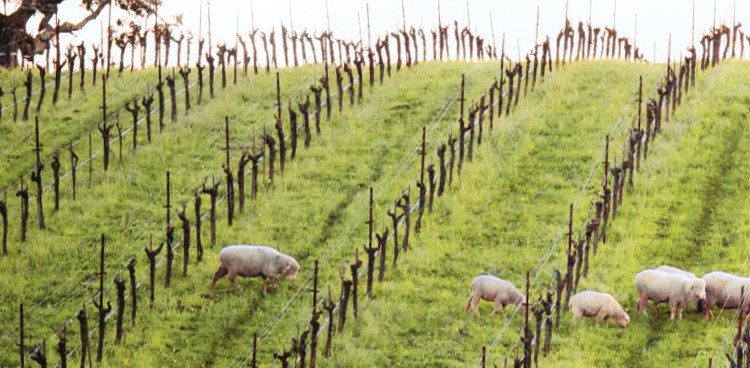
I’m sure there are some energies working, and we try to use them in the right ways,” says Steffen Christmann, a winemaker in Germany’s Pfalz region. “But right now we can only try to understand them – and I hope I’ll be alive when we finally do.”
He’s talking biodynamics, a system of farming based on the teachings of Rudolf Steiner, an Austrian philosopher who presented his ideas in the 1920s. “Biodynamic” is a word that’s been cropping up frequently in the wine world, gaining traction with the trend in natural wine bars like The Ten Bells and Racines in New York City and Terroir in San Francisco.
Biodynamic wine used to be considered a fringe approach, but that’s no longer the case – as witnessed by Christmann, the seventh generation to run his family’s winery and head of Germany’s VDP, a consortium of the country’s long-running top winemakers.
Over the last couple of decades, interest has blossomed in the philosophy, which aims to harness natural forces – whether from plants, animals, insects, or even gravitational pull – to create a healthy environment for crops and animals. It’s similar to organic farming in that it eschews man-made chemicals (herbicides, pesticides, fungicides, and fertilizers), but it goes a few steps further, requiring practitioners to create farming environments that are self-balancing through robust biodiversity. Respect for natural cycles of life, the thinking goes, delivers the most out of both plants and animals.
From a farming perspective, there are pragmatic reasons to turn to biodynamics. Grape growers who convert from conventional farming (the term used to refer to post-World War II, petrochemical-reliant cultivation) to biodynamics regularly report that, after the detox stage, vines are better at weathering drought, wet spells, and other climatic challenges. Vines seem more robust, flexible, and self-regulating – powerful advantages in a world with increasingly scarcer water supplies and drastically variable weather patterns.
In fact, some of the best wines in the world are made by wineries practicing biodynamics (Romanée-Conti, for instance, or Zind-Humbrecht, two legendary French producers). If you believe that the highest calling of wine is to channel the flavor of place—terroir—then it would make sense to look to vineyards farmed in tune with the local environment, rather than ones maintained with chemicals. Consider the difference between factory-raised chicken and free-range birds: Philosophical and ethical questions aside, one simply tastes differently than the other.
Challenges with Cheese
Because cheese, like wine, has an exceptional ability to channel terroir, I went looking for biodynamic cheese… only to find that there aren’t many certified-biodynamic dairies in the US beyond Hawthorne Valley Farm in Upstate New York and Paradise Springs Farm in Teton Valley, Idaho. Elizabeth Candelario, the co-director of Demeter USA, the certifying agency for biodynamics, explains that while the US claims more than 80 certified-biodynamic wineries, barriers for animal products pose more of a challenge, since requirements are so contrary to the status quo.
“The intention [of the Demeter standard] is to allow the animal to fully express its unique characteristics,” Candelario says. “Pigs keep their tails, chickens their beaks, and cows their horns. Access to free range is required. They must have a clean, dry place to sleep at night. A majority of their food must come from the farm itself, and the rest must be NOP [National Organic Program]-certified.”
That said, with retailers like Whole Foods Market and companies such as The Republic of Tea and Lundberg Family Farms beginning to market biodynamic foods, Candelario is hopeful that our future will hold more biodynamic cheese. It already does in Europe, she points out, where food farmers were the first adapters, and vintners followed (unlike in the US, where wine is leading the way). Overseas, it’s not unusual to find cheeses from biodynamic farms in farmers’ markets and even grocery stores.
Of course, biodynamics is not the only way to achieve environmentally responsible, terroir-rich wine and food. Rob Lawler, who runs The Truffle Cheese Shop in Denver, Colo., points out that labels don’t guarantee good taste; many would-be certified producers opt out of the process due to cost. “The farmers that only have a handful of dairy animals won’t want to pay [certification fees] if they are a huge portion of their profits,” he says.
Those concerned about where foods come from shouldn’t seek certification stickers, but instead detailed information about individual farmers, Lawler suggests. For instance, if a customer asks for a cheese from a farm Lawler admires, he might recommend Avalanche Cheese Company, even though it has no official certification.
“It’s basically goat heaven,” Lawler says. “They pasture-feed all of their goats, but feed them some grain when milking to encourage them into the milking stalls.” The grain isn’t certified organic, but that’s not a deal breaker for Lawler. “I’d rather support the cheesemaker who’s buying alfalfa from the guy next door [instead of buying] it from a 20,000-acre organic alfalfa farm in California and [trucking] it across the country,” he says. Which, if you’re looking for the taste of place, makes a lot of sense.





